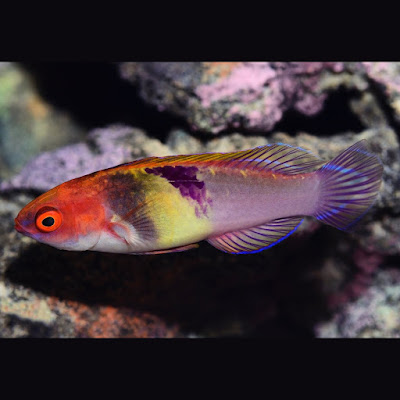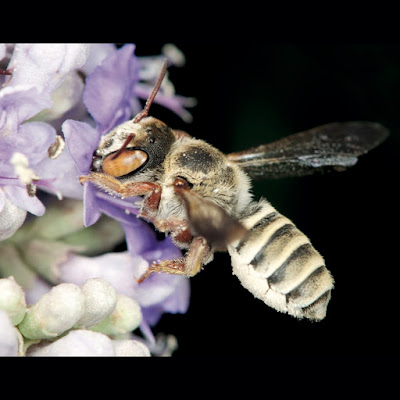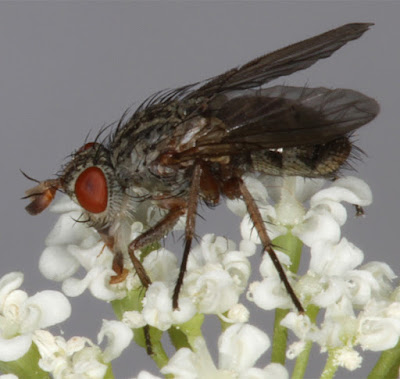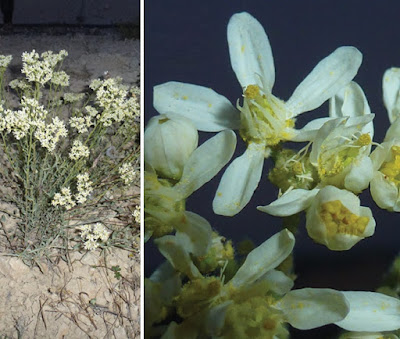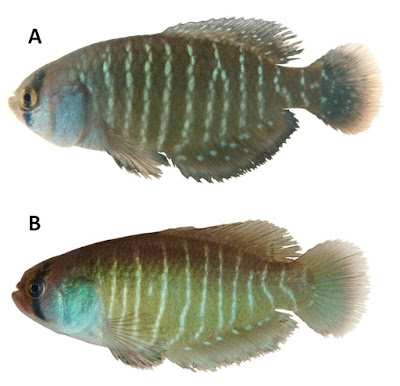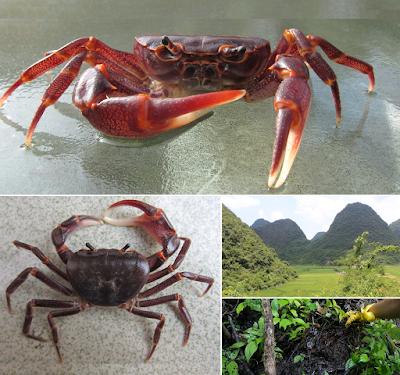[Most Recent Entries] [Calendar View]
Friday, November 30th, 2018
| Time | Event | ||||||||
| 6:15a | [Ichthyology • 2018] Redescription and Phylogenetic Placement of Cirrhilabrus sanguineus Cornic (Teleostei: Labridae), with First Documentation of the Female Form
Abstract The labrid fish Cirrhilabrus sanguineus Cornic is redescribed on the basis of the neotype, two male specimens, and an additional female specimen recently collected from the northern coast of Mauritius. We provide new live and nuptial colouration descriptions, as well as the first documented female specimen for the species. we also include a molecular phylogenetic analysis of related species, with brief comments on phylogenetic interpretation of putative relationships amongst members of the genus Cirrhilabrus. Keywords: Pisces, taxonomy, ichthyology, Mauritius, systematics, fairy wrasse Yi-Kai Tea, Benjamin Frable and Cara Van Der Wal. 2018. Redescription and Phylogenetic Placement of Cirrhilabrus sanguineus Cornic (Teleostei: Labridae), with First Documentation of the Female Form. Zootaxa. 4526(3); 358–372. DOI: 10.11646/zootaxa.4526.3.5 | ||||||||
| 7:57a | [Entomology • 2018] Taxonomic Revision of the Western Palaearctic Bees of the Subgenus Pseudomegachile (Hymenoptera, Apiformes, Megachilidae, Megachile)
Abstract The subgenus Pseudomegachile Friese of the large genus Megachile Latreille is revised for the Western Palaearctic region, Iran, and the Arabian Peninsula. Twenty species are recognized, of which five are new: Megachile blepharis Dorchin & Praz from Israel, M. plumigera Dorchin & Praz from Oman and the United Arab Emirates, M. syriaca Dorchin & Praz from Syria and Turkey, M. yezidica Dorchin & Praz from Turkey and Iran, and M. maxschwarzi Dorchin & Praz from Iran and Central Asia. The following new synonymies are proposed: M. inermis Radoszkowski 1893 (as well as the replacement name M. mitis Cockerell 1899), M. albifasciata Rebmann 1970 and M. transgrediens Rebmann 1970 are placed in synonymy with M. saussurei Radoszkowski 1874; M. tuberculata Radoszkowski 1893 (as well as the replacement name M. tuberculosa Dalla Torre 1896) is placed in synonymy with M. seraxensis Radoszkowski 1893; M. rubripes Morawitz 1875 and M. persica Rebmann 1972 are placed in synonymy with M. flavipes Spinola 1838; M. stolzmanni Radoszkowski 1893 and M. flavidula Rebmann 1970 are placed in synonymy with M. tecta Radoszkowski 1888. Lectotypes are designated for M. cinnamomea Alfken 1926, M. nilotica Pérez 1897, M. inermis, M. seraxensis, M. tuberculata, M. farinosa Smith 1853, M. derasa Gerstäcker 1869, M. erythrocnemis Alfken 1930 and M. xanthocnemis Alfken 1938. An identification key is provided, a phylogenetic hypothesis including most species in the subgenus is presented, and the biology of the species is briefly summarized. Keywords: Hymenoptera, Apiformes, Arabian, Chalicodoma, dauber bees, Mediterranean, mason bees, nesting biology, phylogeny, pollen host, trap nest Achik Dorchin and Christophe J. Praz. 2018. Taxonomic Revision of the Western Palaearctic Bees of the Subgenus Pseudomegachile (Hymenoptera, Apiformes, Megachilidae, Megachile). Zootaxa. 4524(3); 251–307. DOI: 10.11646/zootaxa.4524.3.1  | ||||||||
| 8:16a | [Entomology • 2018] Review of the Genus Trichactia Stein (Diptera: Tachinidae) in the Palaearctic Region, with the Description of A New Species, Trichactia meridiana, from Iran and the East Mediterranean
Abstract The genus Trichactia Stein, 1924 (Diptera: Tachinidae) is newly recorded from Iran and its Palaearctic species are reviewed. The new species Trichactia meridiana Ziegler & Gilasian, sp. nov. is described from Iran and the East Mediterranean. An identification key to the three known Palaearctic species of Trichactia, photographs of all species and illustrations of their male terminalia are provided. Intraspecific variation between different geographical populations of T. meridiana sp. nov. is discussed. Keywords: Diptera, identification key, Middle East, new records, taxonomy, Tachininae Ebrahim Gilasian, Joachim Ziegler and Mehrdad Parchami-Araghi. 2018. Review of the Genus Trichactia Stein (Diptera: Tachinidae) in the Palaearctic Region, with the Description of A New Species from Iran and the East Mediterranean. Zootaxa. 4526(2); 207–220. DOI: 10.11646/zootaxa.4526.2.6 | ||||||||
| 8:36a | [Botany • 2018] Haplophyllum ermenekense (Rutaceae) • A New Species from Turkey Abstract A new species of Haplophyllum, Haplophyllum ermenekense (Rutaceae) is described and illustrated in line drawing. It grows on stony slopes of Ermenek town, Karaman province, in southern Turkey. It is compared with the closely related species H. myrtifolium. H. ermenekense is distinguished from the morphologically similar H. myrtifolium chiefly by sepal shape, petal size, capsule size, presence of capsule hair and appendage form. On the other hand, the seed coat and pollen grains surface of H. ermenekense and H. myrtifolium are demonstrated in SEM photographs. In addition to the detailed description, the illustration, distribution map, conservation status and ecology of the new species are also provided. Keywords: Endemic, Haplophyllum, Karaman, Rutaceae, taxonomy
Haplophyllum ermenekense Ulukuş & Tugay, sp. nov. Diagnosis: Haplophyllum ermenekense most resembles the closely related H. myrtifolium. It differs from H. myrtifolium by its inflorescence usually lax form (versus dense), sepals ovate or ovate-oblong (versus lanceolate or lanceolate-oblong) and deciduous in fruit (versus persistent in fruit), petals 4–5.5 × 1.5–2.5 mm (versus 6.5–9.5 × 3.5–4.5 mm), capsule 2–2.5 × 3–4 mm (versus 3–3.5 × 5–6 mm) and glabrous (in contrast to not glabrous), with a conspicuous usually erect appendage on the outer upper surface (versus incurved appendage on the outer upper portion). Etymology: The name of Ermenek town where new species found is given to the species epithet. Proposed Turkish name for the new species: Ermenek sedosu. Ecology: Haplophyllum ermenekense is endemic to Turkey. It grows at altitudes between 980 and 1200 m on limestone slopes amongst bushes (e.g. Quercus coccifera L., Juniperus oxycedrus L., Pistacia terrebinthus M.Bieb. etc.). Plant diversity in this place is mainly composed of herbaceous and suffruticose plants including Adonis flammea Jacq., Aegilops cylindrica Host, Aethionema stylosum DC., Capsella bursa-pastoris (L.) Medik., Centaurea virgata Lam., Digitalis cariensis Boiss. ex Jaub. & Spach, Ebenus plumosa Boiss. & Bal. subsp. speciosa Boiss.& Bal., Glaucium corniculatum (L.) Rud. subsp. corniculatum, Glaucium leiocarpum Boiss., Hyoscyamus aureus L., Hyoscyamus niger L., Isatis ermenekense Yıld., Micromeria cristata (Hampe) Griseb. subsp. cristata, Salvia albimaculata Hedge & Hub-Mor. and Salvia aucheri Bentham var. canescens Boiss. & Heldr. Distribution and conservation status: Haplophyllum ermenekense is endemic to Karaman province. It is an element belonging to the east Mediterranean phytogeographic region (Fig. 1). The range of this new species is limited to a single locality and its area of occupancy is estimated to be less than 5 km or 5 km2. The number of mature individual plants is estimated to be less than 250. As it is perennial, this new species has a crucial advantage for its future as destruction of the bushes by local people, road construction and deterioration of habitats may cause some threats. Thus, according to criterion D, it can be included in the EN (Endangered) category (IUCN 2001; 2016). Deniz Ulukuş and Osman Tugay. 2018. Haplophyllum ermenekense (Rutaceae), A New Species from Turkey. PhytoKeys. 111: 119-131. DOI: 10.3897/phytokeys.111.24241 | ||||||||
| 3:02p | [Entomology • 2018] Scapsipedus icipe • A New Edible Cricket Species of the Genus Scapsipedus (Orthoptera: Gryllidae) from Kenya, Africa
Abstract A new cricket of the genus Scapsipedus is described from Kenya. The distribution, acoustic behavior, including call and courtship song, mitochondrial sequences, and data on the biology of that new species are given. This edible cricket is a very promising species for mass production for food and feed. Keywords: Orthoptera, new species, bioacoustics, insect farming  Scapsipedus icipe Hugel & Tanga, n. sp. Etymology. This new cricket is named after the type locality, International Centre of Insect Physiology and Ecology (icipe), Duduville Campus, Nairobi, Kenya. Chrysantus M. Tanga, Henlay J. O. Magara, Monica A. Ayieko, Robert S. Copeland, Fathiya M. Khamis, Samira A. Mohamed, Fidelis L. O. Ombura, Saliou Niassy, Sevgan Subramanian, Komi K. M. Fiaboe, Nanna Roos, Sunday Ekesi and Sylvain Hugel. 2018. A New Edible Cricket Species from Africa of the Genus Scapsipedus. Zootaxa. 4486(3): 383–392. DOI: 10.11646/zootaxa.4486.3.9 New edible cricket species discovered in Kenya www.icipe.org/news/new-edible-cricket-sp | ||||||||
| 4:23p | [Ichthyology • 2018] Austrolebias queguay • A New Species of Annual Killifish (Cyprinodontiformes, Rivulidae) Endemic to the lower Uruguay River Basin Abstract In this article we describe a new species of the annual fish genus Austrolebias from the lower Uruguay river basin. The fusion of the urogenital papilla to the first anal fin ray in males and the pigmentation pattern, indicates a close relationship with the clade formed by A. bellottii, A. melanoorus, and A. univentripinnis. The new species can be differentiated from those by the following combination of characters: presence of well-defined light bands contrasting with the sides of the body, the distal portion of the anal fin dark gray, pelvic fins dark bluish green and bases united at about 50–80% on their medial margins, pectoral fins with iridescent blue sub-marginal band, and general coloration of body bluish green. The new species can only be found in wetlands of the Queguay river, an area included in the Uruguayan protected areas system and represents so far the only annual fish species endemic to the lower Uruguay river basin. Key Words: Austrolebias bellottii species group, Systematics, La Plata basin
Austrolebias queguay sp. n. Austrolebias sp. in Loureiro et al. (2018) Diagnosis: The new species differs from all the other species of the genus except Austrolebias bellottii, A. univentripinnis and A. melanoorus, by the presence of the urogenital papilla attached to the anal fin in males (vs. free from the anal fin). It differs from A. bellottii and A. univentripinnis by the presence of well-defined light blue bands contrasting with the sides of the body in adult males (vs. vertical rows of light blue dots) (Fig. 2); from A. melanoorus, by the presence of dark gray coloration of the distal portion of the anal fin in males (vs. distal portion of anal-fin black), pelvic-fins dark bluish green (observed in ventral view) and bases united at about 50–80% on their medial margins (vs. dark gray and united about 50% or less), pectoral-fins with iridescent blue sub-marginal band (vs. sub-marginal band absent), and general coloration of the body bluish green (vs. grayish sky blue). 
Etymology: The specific name, queguay, is in reference to Queguay river basin, the type locality of the new species, treated as a noun in apposition to the generic name. Distribution: Austrolebias queguay is endemic to the wetlands of middle Queguay river basin (30 meters above sea level), Paysandú Department, Uruguay, which flows to the lower Uruguay river (Fig. 6). Ecology: As many species of the family Rivulidae, A. queguay presents an annual life cycle which includes drought resistant eggs and diapausing embryos. All species of Austrolebias are obligate annuals (Berois et al. 2016). In the Pampa biome there is not a defined dry season, so dried environments can be found between mid spring to early fall (depending on the year), when evaporation is higher than precipitations (Williams 2006; García et al. 2017). Austrolebias species can be found in small grassland ponds and seasonal floodplain wetlands; however the new species has been found so far only in the latter environments (Fig. 7). Wilson S. Serra and Marcelo Loureiro. 2018. Austrolebias queguay (Cyprinodontiformes, Rivulidae), A New Species of Annual Killifish Endemic to the lower Uruguay River Basin. Zoosystematics and Evolution. 94(2): 547-556. DOI: 10.3897/zse.94.29115 | ||||||||
| 4:44p | [Crustacea • 2018] Chinapotamon maolanense • A New Species of Karst-dwelling Freshwater Crab of the Genus Chinapotamon Dai & Naiyanetr, 1994 (Decapoda: Brachyura: Potamidae), from Guizhou, southwest China
Abstract Chinapotamon maolanense sp. n. from Maolan National Nature Reserve, Guizhou, southwest China, is described. C. maolanense sp. n. has diagnostic features of Chinapotamon, such as a slender and sinuous male first gonopod, prominently convex carapace, and one-third ratio of frons to carapace width. This new species can be distinguished from congeners by the combination of the following characters: relatively slender subterminal segment of the first gonopods, nearly oval-shaped carapace, anterolateral margin cristate of carapace and an oval-shaped gap between the fingers of the male major chela. In addition, we used a 16S rRNA gene fragment to explore the relationship between C. maolanense sp. n. and C. glabrum, C. depressum and other freshwater crabs distributed in Guizhou; the results support the new species being assigned to Chinapotamon and clearly different from other species used in the analysis.
Family Potamidae Ortmann, 1896 Chinapotamon Dai & Naiyanetr, 1994 Chinapotamon maolanense sp. n. (Figs. 2–7) Materials examined. Holotype: ♂ (35.8 × 25.9 mm) (NCU MCP 196101), ..., Baixian Hill, Banzhai Village, Lino County, Guizhou Province, ..., 532 m asl. Xian-min Zhou, October 2010. Paratypes: 1♀ (allotype) (36.7 × 26.6) (NCU MCP 196107), same data as holotype; 1♂ (32.9 × 25.1 mm) (NCU MCP 196102). Others: 5♂ (40.4 × 30.9, 30.2 × 22.8, 28.9 × 21.4, 27.8 × 20.7, 27.7 × 19.5) (NCU MCP 196103, 196105, 196106, 196109, 196110), same data as holotype; and 2♀ (38.5 × 29.7, 31.6 × 23.5) (NCU MCP 196104, 196108), same data as holotype. Description. Carapace nearly oval, widest at anterior one-third, 1.3–1.4 times as broad as long (mean = 1.34, specimens in the Materials examined sections were measured); dorsal surface (Figs. 2A and 2B) smooth, with inconspicuous small granular depression, prominently convex horizontally at anterior one-third and bent forward and backward. Branchial regions slightly convex laterally, with inconspicuous granular depressions. Epigastric cristae low, separated by a narrow gap; central part of the epigastric region slightly depressed. Postorbital cristae very low, not fused with epigastric cristae. Anterolateral margin distinctly cristate, lined with granules. Frons approximately one-third as wide as the carapace. Orbits (Fig. 2C) suboval. Epistome longitudinally narrow, posterior margin with blunt median lobe (Fig. 2B). Ocular peduncle (Fig. 2C) relative slender, medially constricted, distal end (cornea) and base with approximately same diameter. Etymology. The species is named after the type locality: the Maolan National Nature Reserve.
Ecological note. Karst terrain usually lacks soil and water, but in karst forests such as the Maolan National Nature Reserve, water could be conserved by dead branches and deciduous layers, and groundwater is another source. C. maolanense sp. n. crabs are locally known as “mountain crabs” because the species is generally distributed in low-altitude mountain forests. This species inhabits small mountain streams with low water flow and even moist soil where the surface has no flow; in contrast, most other Chinapotamon species live under stones in streams, while C. dashiwei and C. clarkei live in streams in caves. This species inhabits environments with dead leaves, dead branches, and humus (Fig. 8). Remarks. Chinapotamon is characterized by the sinuous and slender G1, prominently convex dorsal surface of the carapace, and frons approximately one-third as wide as the carapace (Dai, 1999; Ng, 2017). C. maolanense sp. n. has all these features. Compared with the other Chinapotamon species, the shape of the G1 of C. maolanense sp. n. is similar to that of C. anlongense, C. depressum, C. dashiwei, and C. clarkei, but the terminal segment of the G1 of the new species is fairly straight, whereas those of the other four species are clearly curved. The subterminal segment of the G1 of C. maolanense sp. n. is almost as slender as the terminal segment, but the subterminal segment of the other four species are clearly stouter than the terminal segment. Additionally, the nearly ovate and prominent convex carapace, the large, oval-shaped gap between the fingers of the male major chela, and the uncountable granular teeth along the anterolateral margin of C. maolanense sp. n. are all distinguishable features (Table 2). General Discussion: China has the largest area of karst in the world, most of which is located in the subtropical climate zone in southern China (Liu et al., 2014; Zhou, 1987). Based on theoretical inference or speculation due to existing forest fragments, these karst landforms are believed to have been covered with dense forest vegetation before human influence, but these forests are gradually disappearing and are nearly destroyed (Han, Tang & Wu, 2010). Thus, the discovery of the Maolan karst forest and the primitiveness and richness of the forest vegetation in this area have attracted attention from researchers (Han, Tang & Wu, 2010), but biodiversity surveys in this region have mainly focused on plants (Zhou, 1987). Among the collections of freshwater crab specimens in this area, we found a new species described herein as C. maolanense sp. n. Most known Chinapotamon species are distributed in Guangxi and Guangdong Provinces, China, except for C. anlongense and C. xingrenense from southwest Guizhou Province, where the average altitude is 1,000–2,000 m. Dai (1999) also collected observations at altitudes above 1,000 m. However, the average altitude of the type locality of C. maolanense in southern Guizhou Province is approximately 500 m, and the main terrain of this area is a low karst peak cluster instead of high mountains. In contrast to the other karst-dwelling crabs, the specimens of C. maolanense were not collected from caves but rather from the humus layer in the forest with small water flow or even just a wet environment; this is a rare habitat for freshwater crabs. In this case, we speculate that this species may have more athletic ability. Jie-Xin Zou, Jun Bai and Xian-Min Zhou. 2018. A New Species of Karst-dwelling Freshwater Crab of the Genus Chinapotamon Dai & Naiyanetr, 1994 (Crustacea: Decapoda: Brachyura: Potamidae), from Guizhou, southwest China. PeerJ. 6:e5947. DOI: 10.7717/peerj.5947 |
| << Previous Day |
2018/11/30 [Calendar] |
Next Day >> |
